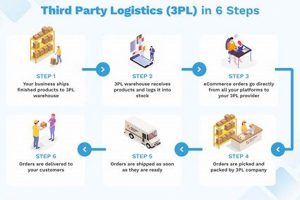
Logistics services are the activities involved in planning, executing, and controlling the movement of goods and services from origin to destination, ensuring that the right product gets to the right place, at the right time, in the right condition, and at the right cost. These services include transportation, warehousing, inventory management, material handling, order fulfillment, and customer service.
Logistics services are essential for businesses of all sizes, as they help to reduce costs, improve efficiency, and enhance customer satisfaction. By partnering with a logistics provider, businesses can gain access to a wide range of expertise and resources, allowing them to focus on their core competencies.
The history of logistics services dates back to the early days of trade and commerce. As businesses began to expand their operations beyond local markets, they needed to find ways to transport their goods and services over long distances. This led to the development of transportation networks, warehouses, and other logistics infrastructure.
1. Planning
Planning is the foundation of effective logistics services. It involves determining the most efficient way to move goods from origin to destination, taking into account factors such as cost, time, and quality. Good planning can help to reduce costs, improve efficiency, and enhance customer satisfaction.
There are a number of different planning techniques that can be used in logistics, including:
- Transportation planning: This involves determining the most efficient way to transport goods from one location to another. Factors to consider include the type of goods being transported, the distance, the time frame, and the cost.
- Warehousing planning: This involves determining the best way to store goods in a warehouse. Factors to consider include the type of goods being stored, the amount of space available, and the cost.
- Inventory planning: This involves determining the optimal level of inventory to keep on hand. Factors to consider include the demand for the goods, the cost of holding inventory, and the risk of stockouts.
By carefully planning each step of the logistics process, businesses can ensure that their goods are delivered to the right place, at the right time, and in the right condition.
Real-life example:
One example of the importance of planning in logistics is the case of Amazon.com. Amazon has a highly efficient logistics network that allows it to deliver goods to customers quickly and cheaply. One of the key factors behind Amazon’s success is its use of data and analytics to plan its logistics operations. Amazon uses data to determine the most efficient way to ship goods from its warehouses to customers, taking into account factors such as the location of the customer, the type of goods being shipped, and the time of day.
Conclusion:
Planning is an essential component of effective logistics services. By carefully planning each step of the logistics process, businesses can ensure that their goods are delivered to the right place, at the right time, and in the right condition.
2. Execution
Execution is the process of carrying out the logistics plan and ensuring that goods are delivered on time and in good condition. It involves a number of different activities, including:
- Transportation: This involves moving goods from one location to another. It can be done by truck, rail, ship, or air.
- Warehousing: This involves storing goods in a warehouse until they are needed.
- Inventory management: This involves keeping track of the inventory levels and ensuring that there is enough stock to meet demand.
- Material handling: This involves moving goods within a warehouse or from one location to another.
- Order fulfillment: This involves picking, packing, and shipping orders to customers.
- Customer service: This involves providing customer support and resolving any issues that arise.
Execution is a critical part of logistics services. If the execution is not done properly, it can lead to delays, damage, and lost sales. Therefore, it is important to have a well-trained and experienced team of logistics professionals to execute the plan.
Real-life examples:
One example of the importance of execution in logistics is the case of Walmart. Walmart has a highly efficient logistics network that allows it to deliver goods to its stores quickly and cheaply. One of the key factors behind Walmart’s success is its use of technology to execute its logistics operations. Walmart uses a variety of technologies, including RFID tags, GPS tracking, and automated sorting systems, to ensure that goods are delivered to the right place, at the right time, and in the right condition.
Another example of the importance of execution in logistics is the case of Amazon.com. Amazon has a highly efficient logistics network that allows it to deliver goods to customers quickly and cheaply. One of the key factors behind Amazon’s success is its use of data and analytics to execute its logistics operations. Amazon uses data to determine the most efficient way to ship goods from its warehouses to customers, taking into account factors such as the location of the customer, the type of goods being shipped, and the time of day.
Conclusion:
Execution is a critical part of logistics services. By carefully executing the logistics plan, businesses can ensure that their goods are delivered to the right place, at the right time, and in the right condition.
3. Control
Control is a critical component of logistics services. It involves monitoring the progress of shipments and making necessary adjustments to ensure that goods are delivered on time and in good condition. Control is also important for ensuring that logistics services are efficient and cost-effective.
There are a number of different ways to control logistics services. One common method is to use a transportation management system (TMS). A TMS is a software program that helps businesses to plan, execute, and control their transportation operations. TMSs can be used to track the progress of shipments, identify potential problems, and make necessary adjustments.
Another important aspect of control is inventory management. Inventory management involves keeping track of the inventory levels and ensuring that there is enough stock to meet demand. Good inventory management can help to reduce costs and improve customer satisfaction.
Control is essential for ensuring that logistics services are efficient, effective, and cost-effective. By carefully controlling the logistics process, businesses can ensure that their goods are delivered to the right place, at the right time, and in the right condition.
Real-life example:
One example of the importance of control in logistics is the case of Amazon.com. Amazon has a highly efficient logistics network that allows it to deliver goods to customers quickly and cheaply. One of the key factors behind Amazon’s success is its use of technology to control its logistics operations. Amazon uses a variety of technologies, including RFID tags, GPS tracking, and automated sorting systems, to ensure that goods are delivered to the right place, at the right time, and in the right condition.
Conclusion:
Control is a critical component of logistics services. By carefully controlling the logistics process, businesses can ensure that their goods are delivered to the right place, at the right time, and in the right condition.
4. Transportation
Transportation is a critical component of logistics services. It involves the movement of goods from one location to another, and it can be done by truck, rail, ship, or air. Transportation is essential for businesses of all sizes, as it allows them to get their products to market and to their customers.
There are a number of different factors to consider when choosing a transportation method, including the type of goods being transported, the distance, the time frame, and the cost. It is important to choose the most efficient and cost-effective transportation method for the specific needs of the business.
Transportation is a complex and challenging process, but it is essential for the success of any business. By understanding the different transportation options and how to choose the best method for their needs, businesses can improve their efficiency and profitability.
Real-life example:
One example of the importance of transportation in logistics is the case of Amazon.com. Amazon has a highly efficient logistics network that allows it to deliver goods to customers quickly and cheaply. One of the key factors behind Amazon’s success is its use of technology to optimize its transportation operations. Amazon uses a variety of technologies, including RFID tags, GPS tracking, and automated sorting systems, to ensure that goods are delivered to the right place, at the right time, and in the right condition.
Conclusion:
Transportation is a critical component of logistics services. By understanding the different transportation options and how to choose the best method for their needs, businesses can improve their efficiency and profitability.
5. Warehousing
Warehousing is a critical component of logistics services. It involves the storage of goods until they are needed by the customer. Warehousing is important because it allows businesses to maintain inventory levels, meet customer demand, and provide efficient delivery of goods.
There are a number of different types of warehouses, each with its own purpose and function. Some warehouses are used for the storage of raw materials, while others are used for the storage of finished goods. Some warehouses are large and automated, while others are small and manual.
The choice of warehouse type depends on a number of factors, including the type of goods being stored, the volume of goods being stored, and the budget of the business. It is important to choose the right type of warehouse for the specific needs of the business.
Warehousing is a complex and challenging process, but it is essential for the success of any business. By understanding the different types of warehouses and how to choose the best type for their needs, businesses can improve their efficiency and profitability.
Real-life example:
One example of the importance of warehousing in logistics is the case of Amazon.com. Amazon has a highly efficient logistics network that allows it to deliver goods to customers quickly and cheaply. One of the key factors behind Amazon’s success is its use of warehousing to store its inventory. Amazon has a network of warehouses located around the world, which allows it to quickly and efficiently deliver goods to customers.
Conclusion:
Warehousing is a critical component of logistics services. By understanding the different types of warehouses and how to choose the best type for their needs, businesses can improve their efficiency and profitability.
6. Inventory Management
Inventory management is a critical component of logistics services. It involves keeping track of the inventory levels and ensuring that there is enough stock to meet demand. Good inventory management can help to reduce costs, improve customer satisfaction, and increase profitability.
There are a number of different inventory management techniques that can be used, including:
- Just-in-time (JIT) inventory: JIT inventory is a method of inventory management that seeks to minimize the amount of inventory on hand. JIT inventory is based on the principle of producing goods only when they are needed. This can help to reduce inventory costs and improve cash flow.
- Safety stock: Safety stock is a buffer of inventory that is kept on hand to protect against unexpected increases in demand or disruptions in the supply chain. Safety stock can help to ensure that customers have the products they need, even when there are unexpected events.
- Economic order quantity (EOQ): EOQ is a formula that can be used to determine the optimal quantity of inventory to order at a time. EOQ takes into account factors such as the cost of inventory, the cost of ordering, and the demand for the product.
Effective inventory management is essential for the success of any logistics operation. By carefully managing inventory levels, businesses can reduce costs, improve customer satisfaction, and increase profitability.
Real-life example:
One example of the importance of inventory management in logistics is the case of Amazon.com. Amazon has a highly efficient logistics network that allows it to deliver goods to customers quickly and cheaply. One of the key factors behind Amazon’s success is its use of inventory management to optimize its inventory levels. Amazon uses a variety of inventory management techniques, including JIT inventory, safety stock, and EOQ, to ensure that it has the right products in stock to meet customer demand.
Conclusion:
Inventory management is a critical component of logistics services. By effectively managing inventory levels, businesses can reduce costs, improve customer satisfaction, and increase profitability.
7. Material Handling
Material handling is an essential component of logistics services that involves the movement, storage, and control of materials within a manufacturing, warehousing, or distribution operation. It ensures that materials are available when and where they are needed, contributing to the efficient and cost-effective flow of goods throughout the supply chain.
Effective material handling practices optimize the utilization of space, reduce labor costs, and improve overall productivity. Proper equipment selection, such as forklifts, conveyors, and automated systems, plays a crucial role in streamlining material handling processes and increasing operational efficiency.
The importance of material handling in logistics services is evident in its impact on various aspects of the supply chain. For instance, efficient material handling can reduce lead times by ensuring that raw materials are delivered to production lines on time, minimizing production delays and expediting the delivery of finished goods to customers.
Moreover, effective material handling contributes to cost reduction by minimizing damage and waste, optimizing inventory levels, and reducing the need for manual labor. Advanced material handling systems, such as automated storage and retrieval systems (ASRS), can significantly enhance space utilization, increase storage capacity, and improve picking and retrieval accuracy.
Understanding the connection between material handling and logistics services allows businesses to identify opportunities for improvement and gain a competitive advantage. By implementing efficient material handling practices, organizations can streamline their operations, reduce costs, and enhance customer satisfaction.
8. Order Fulfillment
Order fulfillment is a critical component of logistics services, encompassing the processes involved in receiving, processing, and delivering customer orders. Effective order fulfillment ensures that orders are fulfilled accurately, efficiently, and on time, contributing to customer satisfaction and business success.
- Order Processing: Order processing involves activities such as receiving orders from customers, verifying order details, and checking inventory availability. Efficient order processing systems enable businesses to quickly and accurately process orders, reducing the risk of errors and delays.
- Inventory Management: Order fulfillment relies heavily on effective inventory management to ensure that the right products are available to fulfill customer orders. Proper inventory management practices optimize stock levels, minimize the risk of stockouts, and support efficient order picking and packing.
- Shipping and Delivery: Shipping and delivery involve selecting the appropriate shipping methods, packaging orders securely, and coordinating with carriers to ensure timely delivery to customers. Efficient shipping and delivery processes minimize transit times, reduce shipping costs, and enhance the overall customer experience.
- Tracking and Visibility: Order fulfillment systems often provide tracking and visibility features, allowing customers to track the status of their orders and receive updates on estimated delivery times. This transparency and real-time information enhance customer satisfaction and build trust.
The connection between order fulfillment and logistics services is evident in the seamless flow of goods from suppliers to customers. Efficient order fulfillment practices contribute to reduced lead times, improved inventory management, optimized shipping costs, and enhanced customer experiences. By understanding the components and implications of order fulfillment, businesses can align their logistics services with customer expectations and drive business growth.
9. Customer Service
Customer service is a critical component of logistics services that focuses on building and maintaining positive relationships with customers by resolving their inquiries, addressing their concerns, and ensuring their satisfaction with the overall logistics experience.
- Communication: Effective communication is vital in customer service, as it allows logistics providers to promptly address customer inquiries and provide clear and accurate information regarding the status of shipments, delivery schedules, and any potential issues.
- Responsiveness: Timely and responsive customer service is essential to ensure that customer concerns are addressed promptly and efficiently. Logistics providers should establish clear channels of communication and set realistic response times to maintain customer satisfaction and trust.
- Problem Resolution: Customer service representatives should be equipped to handle customer issues and complaints effectively. This involves thoroughly understanding the customer’s situation, identifying the root cause of the problem, and working towards a mutually acceptable solution.
- Feedback Management: Gathering and analyzing customer feedback is crucial for continuous improvement in logistics services. Customer service teams play a key role in collecting and relaying customer feedback to relevant departments within the organization, enabling the logistics provider to identify areas for improvement and enhance the overall customer experience.
By providing exceptional customer service, logistics providers can build strong relationships with their clients, increase customer retention, and foster a positive reputation within the industry. Effective customer service contributes to the overall success of logistics services by ensuring customer satisfaction, driving business growth, and creating a competitive advantage.
FAQs on Meaning of Logistics Services
Logistics services play a crucial role in the movement of goods and the flow of supply chains. To understand the concept of logistics services better, let’s delve into some frequently asked questions (FAQs) and their answers.
Question 1: What is the definition of logistics services?
Answer: Logistics services encompass the activities involved in planning, executing, and controlling the movement of goods and services from their origin to their destination. These services include transportation, warehousing, inventory management, material handling, order fulfillment, and customer service.
Question 2: What are the benefits of using logistics services?
Answer: Logistics services provide numerous benefits to businesses, such as reduced costs, improved efficiency, enhanced customer satisfaction, increased flexibility, and access to expertise and resources.
Question 3: What factors should be considered when choosing a logistics provider?
Answer: When selecting a logistics provider, factors such as reliability, experience, cost, technology, customer service, and industry expertise should be taken into account.
Question 4: How can logistics services contribute to business growth?
Answer: Effective logistics services can streamline operations, optimize inventory management, reduce lead times, and enhance customer loyalty, all of which contribute to business growth and profitability.
Question 5: What are the key trends in logistics services?
Answer: Key trends in logistics services include the adoption of technology, such as blockchain and AI, the rise of e-commerce and omnichannel fulfillment, the focus on sustainability, and the increasing importance of data analytics.
Question 6: How can businesses stay competitive in the logistics industry?
Answer: To remain competitive, businesses should embrace digital transformation, invest in technology, optimize their supply chains, and build strong partnerships with logistics providers.
Understanding the meaning and importance of logistics services empowers businesses to optimize their supply chains, reduce costs, and enhance customer satisfaction. By leveraging the expertise of logistics providers and staying abreast of industry trends, businesses can gain a competitive advantage and drive business growth.
Transitioning to the next article section…
Tips on Leveraging Logistics Services Effectively
Logistics services are essential for businesses of all sizes, as they can help to reduce costs, improve efficiency, and enhance customer satisfaction. By following these tips, businesses can make the most of their logistics partnerships and achieve their business goals.
Tip 1: Define Your Logistics Needs
Before selecting a logistics provider, it is important to clearly define your business’s logistics needs. Consider factors such as the types of goods being shipped, the frequency of shipments, the desired transit times, and the budget.
Tip 2: Research and Compare Logistics Providers
Take the time to research and compare different logistics providers. Consider their experience, reputation, cost structure, technology, and customer service capabilities. Look for providers that align with your business’s specific needs and can offer tailored solutions.
Tip 3: Establish Clear Communication Channels
Open and effective communication is crucial for successful logistics partnerships. Establish clear communication channels with your logistics provider and set expectations regarding regular updates, reporting, and issue resolution.
Tip 4: Utilize Technology for Visibility and Efficiency
Leverage technology to gain real-time visibility into your supply chain and improve efficiency. Utilize tracking systems, inventory management software, and data analytics to optimize inventory levels, reduce lead times, and enhance customer service.
Tip 5: Foster a Collaborative Partnership
View your logistics provider as a partner, not just a vendor. Foster a collaborative relationship based on trust and mutual respect. Work together to identify areas for improvement and develop innovative solutions that drive business value.
Tip 6: Continuously Evaluate and Improve
Logistics is a constantly evolving field. Regularly evaluate your logistics operations and identify areas for improvement. Seek feedback from your logistics provider and customers to drive continuous improvement and stay ahead of industry trends.
Summary
By following these tips, businesses can effectively leverage logistics services to streamline their supply chains, reduce costs, improve customer satisfaction, and gain a competitive advantage. Remember, logistics is not just a cost center but a strategic asset that can drive business growth and success.
Conclusion
In conclusion, logistics services play a pivotal role in the global economy, facilitating the seamless flow of goods and materials across borders and industries. Logistics service providers act as the backbone of supply chains, ensuring that products reach consumers efficiently, cost-effectively, and on time.
The exploration of “meaning logistics services” in this article illuminated key aspects of this critical field, from planning and execution to inventory management and customer service. By understanding the complexities and importance of logistics services, businesses can make informed decisions and optimize their supply chains to gain a competitive edge.
As technology continues to advance and global economies become increasingly interconnected, the demand for efficient and reliable logistics services will only grow. By embracing innovation, fostering collaboration, and investing in strategic partnerships, businesses can harness the power of logistics services to drive growth, enhance customer satisfaction, and contribute to the overall economic prosperity.






